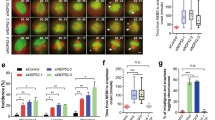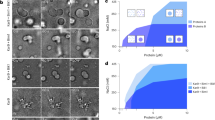Abstract
Regulation of microtubule dynamics at the cell cortex is important for cell motility, morphogenesis and division. Here we show that the Drosophila katanin Dm-Kat60 functions to generate a dynamic cortical-microtubule interface in interphase cells. Dm-Kat60 concentrates at the cell cortex of S2 Drosophila cells during interphase, where it suppresses the polymerization of microtubule plus-ends, thereby preventing the formation of aberrantly dense cortical arrays. Dm-Kat60 also localizes at the leading edge of migratory D17 Drosophila cells and negatively regulates multiple parameters of their motility. Finally, in vitro, Dm-Kat60 severs and depolymerizes microtubules from their ends. On the basis of these data, we propose that Dm-Kat60 removes tubulin from microtubule lattice or microtubule ends that contact specific cortical sites to prevent stable and/or lateral attachments. The asymmetric distribution of such an activity could help generate regional variations in microtubule behaviours involved in cell migration.
This is a preview of subscription content, access via your institution
Access options
Subscribe to this journal
Receive 12 print issues and online access
$209.00 per year
only $17.42 per issue
Buy this article
- Purchase on Springer Link
- Instant access to full article PDF
Prices may be subject to local taxes which are calculated during checkout







Similar content being viewed by others
References
van der Vaart, B., Akhmanova, A. & Straube, A. Regulation of microtubule dynamic instability. Biochem. Soc. Trans. 37, 1007–1013 (2009).
Jaworski, J., Hoogenraad, C. C. & Akhmanova, A. Microtubule plus-end tracking proteins in differentiated mammalian cells. Int. J. Biochem. Cell Biol. 40, 619–637 (2008).
Martin, S. G. Microtubule-dependent cell morphogenesis in the fission yeast. Trends Cell Biol. 19, 447–454 (2009).
Siegrist, S. E. & Doe, C. Q. Microtubule-induced cortical cell polarity. Genes Dev. 21, 483–496 (2007).
Watanabe, T., Noritake, J. & Kaibuchi, K. Regulation of microtubules in cell migration. Trends Cell Biol. 15, 76–83 (2005).
Siller, K. H. & Doe, C. Q. Spindle orientation during asymmetric cell division. Nat. Cell Biol. 11, 365–374 (2009).
Roll-Mecak, A. & McNally, F. J. Microtubule-severing enzymes. Curr. Opin. Cell Biol. 22, 96–103 (2010).
McNally, F. J. & Vale, R. D. Identification of katanin, an ATPase that severs and disassembles stable microtubules. Cell 75, 419–429 (1993).
Buster, D., McNally, K. & McNally, F. J. Katanin inhibition prevents the redistribution of gamma-tubulin at mitosis. J. Cell Sci. 115, 1083–1092 (2002).
McNally, K., Audhya, A., Oegema, K. & McNally, F. J. Katanin controls mitotic and meiotic spindle length. J. Cell Biol. 175, 881–891 (2006).
Srayko, M., O’Toole, E. T., Hyman, A. A. & Muller-Reichert, T. Katanin disrupts the microtubule lattice and increases polymer number in C. elegans meiosis. Curr. Biol. 16, 1944–1949 (2006).
Zhang, D., Rogers, G. C., Buster, D. W. & Sharp, D. J. Three microtubule severing enzymes contribute to the ‘Pacman-flux’ machinery that moves chromosomes. J. Cell Biol. 177, 231–242 (2007).
Karabay, A., Yu, W., Solowska, J. M., Baird, D. H. & Baas, P. W. Axonal growth is sensitive to the levels of katanin, a protein that severs microtubules. J. Neurosci. 24, 5778–5788 (2004).
Yu, W. et al. The microtubule-severing proteins spastin and katanin participate differently in the formation of axonal branches. Mol. Biol. Cell 19, 1485–1498 (2008).
Casanova, M. et al. Microtubule-severing proteins are involved in flagellar length control and mitosis in Trypanosomatids. Mol. Microbiol. 71, 1353–1370 (2009).
Quarmby, L. Cellular Samurai: katanin and the severing of microtubules. J. Cell Sci. 113Pt 16, 2821–2827 (2000).
Rasi, M. Q., Parker, J. D., Feldman, J. L., Marshall, W. F. & Quarmby, L. M. Katanin knockdown supports a role for microtubule severing in release of basal bodies before mitosis in Chlamydomonas. Mol. Biol. Cell 20, 379–388 (2009).
Sharma, N. et al. Katanin regulates dynamics of microtubules and biogenesis of motile cilia. J. Cell Biol. 178, 1065–1079 (2007).
Stoppin-Mellet, V. et al. Arabidopsis katanin binds microtubules using amultimeric microtubule-binding domain. Plant Physiol. Biochem. 45, 867–877 (2007).
Stoppin-Mellet, V., Gaillard, J. & Vantard, M. Katanin’s severing activity favours bundling of cortical microtubules in plants. Plant J. 46, 1009–1017 (2006).
Burk, D. H., Zhong, R. Q. & Ye, Z. H. The katanin microtubule severing protein in plants. J. Integr. Plant Biol. 49, 1174–1182 (2007).
Burk, D. H., Liu, B., Zhong, R. Q., Morrison, W. H. & Ye, Z. H. A Katanin-like protein regulates normal cell wall biosynthesis and cell elongation. Plant Cell 13, 807–827 (2001).
Nakamura, M., Ehrhardt, D. W. & Hashimoto, T. Microtubule and katanin-dependent dynamics of microtubule nucleation complexes in the acentrosomal Arabidopsis cortical array. Nat. Cell Biol. 12, 1064–1070 (2010).
Mennella, V. et al. Functionally distinct kinesin-13 family members cooperate to regulate microtubule dynamics during interphase. Nat. Cell Biol. 7, U235–U239 (2005).
Ozon, S., Guichet, A., Gavet, O., Roth, S. & Sobel, A. Drosophila stathmin: a microtubule-destabilizing factor involved in nervous system formation. Mol. Biol. Cell 13, 698–710 (2002).
Lee, H. et al. The microtubule plus end tracking protein Orbit/MAST/CLASP acts downstream of the tyrosine kinase Abl in mediating axon guidance. Neuron 42, 913–926 (2004).
Jankovics, F. & Brunner, D. Transiently reorganized microtubules are essential for zippering during dorsal closure in Drosophila melanogaster. Dev. Cell 11, 375–385 (2006).
Borghese, L. et al. Systematic analysis of the transcriptional switch inducing migration of border cells. Dev. Cell 10, 497–508 (2006).
Ui, K., Ueda, R. & Miyake, T. Cell lines from imaginal discs of Drosophila melanogaster. In Vitro Cell Dev. Biol. 23, 707–711 (1987).
Stramer, B. et al. Clasp-mediated microtubule bundling regulates persistent motility and contact repulsion in Drosophila macrophages in vivo. J. Cell Biol. 189, 681–689 (2010).
Kurtti, T. J. & Brooks, M. A. Growth and differentiation of lepidopteran myoblasts in vitro. Exp. Cell Res. 61, 407–412 (1970).
Merchant, D., Ertl, R. L., Rennard, S. I., Stanley, D. W. & Miller, J. S. Eicosanoids mediate insect hemocyte migration. J. Insect Physiol. 54, 215–221 (2008).
Roll-Mecak, A. & Vale, R. D. The Drosophila homologue of the hereditary spastic paraplegia protein, spastin, severs and disassembles microtubules. Curr. Biol. 15, 650–655 (2005).
Torres, J. Z., Miller, J. J. & Jackson, P. K. High-throughput generation of tagged stable cell lines for proteomic analysis. Proteomics 9, 2888–2891 (2009).
Sonbuchner, T. M., Rath, U. & Sharp, D. J. KL1 is a novel microtubule severing enzyme that regulates mitotic spindle architecture. Cell Cycle 9, 2403–2411 (2010).
Waterman-Storer, C. et al. Microtubules remodel actomyosin networks in Xenopus egg extracts via two mechanisms of F-actin transport. J. Cell Biol. 150, 361–376 (2000).
Watanabe, T., Noritake, J. & Kaibuchi, K. Roles of IQGAP1 in cell polarization and migration. Novartis Found Symp. 269, 92–101 (2005).
Waterman-Storer, C. M. & Salmon, E. D. Actomyosin-based retrograde flow of microtubules in the lamella of migrating epithelial cells influences microtubule dynamic instability and turnover and is associated with microtubule breakage and treadmilling. J. Cell Biol. 139, 417–434 (1997).
Waterman-Storer, C. M., Worthylake, R. A., Liu, B. P., Burridge, K. & Salmon, E. D. Microtubule growth activates Rac1 to promote lamellipodial protrusion in fibroblasts. Nat. Cell Biol. 1, 45–50 (1999).
McNally, F. J. & Thomas, S. Katanin is responsible for the M-phase microtubule-severing activity in Xenopus eggs. Mol. Biol. Cell 9, 1847–1861 (1998).
Hartman, J. J. & Vale, R. D. Microtubule disassembly by ATP-dependent oligomerization of the AAA enzyme katanin. Science 286, 782–785 (1999).
Rath, U. et al. The Drosophila kinesin-13, KLP59D, impacts Pacman- and Flux-based chromosome movement. Mol. Biol. Cell 20, 4696–4705 (2009).
Desai, A., Verma, S., Mitchison, T. J., Walczak, C. E. & Kin, I. Kinesins are microtubule-destabilizing enzymes. Cell 96, 69–78 (1999).
Smith, T. F., Gaitatzes, C., Saxena, K. & Neer, E. J. The WD repeat: a common architecture for diverse functions. Trends Biochem. Sci. 24, 181–185 (1999).
Hudson, A. M. & Cooley, L. Understanding the function of actin-binding proteins through genetic analysis of Drosophila oogenesis. Annu. Rev. Genet. 36, 455–488 (2002).
Hartman, J. J. et al. Katanin, a microtubule-severing protein, is a novel AAA ATPase that targets to the centrosome using a WD40-containing subunit. Cell 93, 277–287 (1998).
McNally, K. P., Bazirgan, O. A. & McNally, F. J. Two domains of p80 katanin regulate microtubule severing and spindle pole targeting by p60 katanin. J. Cell Sci. 113Pt 9, 1623–1633 (2000).
Yu, W. et al. Regulation of microtubule severing by katanin subunits during neuronal development. J. Neurosci. 25, 5573–5583 (2005).
Varga, V. et al. Yeast kinesin-8 depolymerizes microtubules in a length-dependent manner. Nat. Cell Biol. 8, 957–962 (2006).
Gupta, M. L. Jr, Carvalho, P., Roof, D. M. & Pellman, D. Plus end-specific depolymerase activity of Kip3, a kinesin-8 protein, explains its role in positioning the yeast mitotic spindle. Nat. Cell Biol. 8, 913–923 (2006).
Sproul, L. R., Anderson, D. J., Mackey, A. T., Saunders, W. S. & Gilbert, S. P. Cik1 targets the minus-end kinesin depolymerase kar3 to microtubule plus ends. Curr. Biol. 15, 1420–1427 (2005).
Mimori-Kiyosue, Y., Shiina, N. & Tsukita, S. The dynamic behaviour of the APC-binding protein EB1 on the distal ends of microtubules. Curr. Biol. 10, 865–868 (2000).
Mishima, M. et al. Structural basis for tubulin recognition by cytoplasmic linker protein 170 and its autoinhibition. Proc. Natl Acad. Sci. USA 104, 10346–10351 (2007).
Montenegro Gouveia, S. et al. In vitro reconstitution of the functional interplay between MCAK and EB3 at microtubule plus ends. Curr. Biol. 20, 1717–1722 (2010).
Rogers, S. L., Rogers, G. C., Sharp, D. J. & Vale, R. D. Drosophila EB1 is important for proper assembly, dynamics, and positioning of the mitotic spindle. J. Cell Biol. 158, 873–884 (2002).
Reed, N. A. et al. Microtubule acetylation promotes kinesin-1 binding and transport. Curr. Biol. 16, 2166–2172 (2006).
Acknowledgements
D.J.S., U.R. and D.Z. were supported by NIH grant no. R01-GM065940 (to D.J.S.). S.L.R., K.D.G. and J.D.C. were supported by March of Dimes grant no. 1-FY08-429 and NIH grant no. R01 GM081645 (both to S.L.R.). S.F.S. and A.M. were supported by NIH grant no. R01-GM086536 (to A.M.). J.L.R. and J.D.D-V. were supported by March of Dimes grant no. 5-FY09-47 (to J.L.R.). H.J.S., A.B.A., E.L. and T.R. were supported by NIH grant no. R01-GM083338 (to H.J.S.).
Author information
Authors and Affiliations
Contributions
D.Z. carried out and analysed most experiments using Drosophila S2 and human cells. D.Z. also purified and carried out the initial in vitro characterization of rDm-Kat60. K.D.G. carried out most experiments with Drosophila D17 under the direction of S.L.R.; J.D.C. also carried out analyses in D17 cells. S.F.S. designed the automated tracking algorithm under the direction of A.M. and used it to track microtubules in live-cell movies provided by D.Z.; J.D.D-V. and J.L.R. carried out numerous in vitro assays to quantify the microtubule-severing and end-depolymerase activities of rDM-Kat-60. A.B.A., E.L. and T.R. carried out and analysed the electron microscopy under the direction of H.J.S. U.R. carried out KLP59D for the electron microscopy assay. D.W.B. helped in the design of many experiments in S2 cells and made the model figure shown in Supplementary Information. D.J.S. wrote the manuscript (with the help of all authors, but particularly S.L.R.) and coordinated the efforts of the multiple laboratories involved in this project.
Corresponding author
Ethics declarations
Competing interests
The authors declare no competing financial interests.
Supplementary information
Supplementary Information
Supplementary Information (PDF 1223 kb)
Supplementary Movie 1
Supplementary Information (AVI 4228 kb)
Supplementary Movie 2
Supplementary Information (AVI 5948 kb)
Supplementary Movie 3
Supplementary Information (AVI 2179 kb)
Supplementary Movie 4
Supplementary Information (AVI 5487 kb)
Rights and permissions
About this article
Cite this article
Zhang, D., Grode, K., Stewman, S. et al. Drosophila katanin is a microtubule depolymerase that regulates cortical-microtubule plus-end interactions and cell migration. Nat Cell Biol 13, 361–369 (2011). https://doi.org/10.1038/ncb2206
Received:
Accepted:
Published:
Issue Date:
DOI: https://doi.org/10.1038/ncb2206
This article is cited by
-
The Microtubule Severing Protein Katanin Regulates Proliferation of Neuronal Progenitors in Embryonic and Adult Neurogenesis
Scientific Reports (2019)
-
Microtubule minus-end regulation at spindle poles by an ASPM–katanin complex
Nature Cell Biology (2017)
-
Self-repair promotes microtubule rescue
Nature Cell Biology (2016)
-
Fidgetin-Like 2: A Microtubule-Based Regulator of Wound Healing
Journal of Investigative Dermatology (2015)
-
Control of microtubule organization and dynamics: two ends in the limelight
Nature Reviews Molecular Cell Biology (2015)



